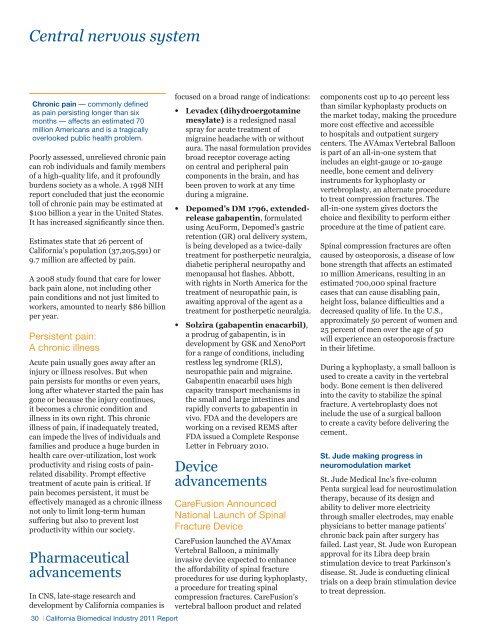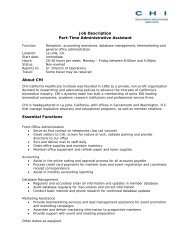California Biomedical Industry - California Healthcare Institute
California Biomedical Industry - California Healthcare Institute
California Biomedical Industry - California Healthcare Institute
You also want an ePaper? Increase the reach of your titles
YUMPU automatically turns print PDFs into web optimized ePapers that Google loves.
Central nervous systemChronic pain — commonly definedas pain persisting longer than sixmonths — affects an estimated 70million Americans and is a tragicallyoverlooked public health problem.Poorly assessed, unrelieved chronic paincan rob individuals and family membersof a high-quality life, and it profoundlyburdens society as a whole. A 1998 NIHreport concluded that just the economictoll of chronic pain may be estimated at$100 billion a year in the United States.It has increased significantly since then.Estimates state that 26 percent of<strong>California</strong>’s population (37,205,591) or9.7 million are affected by pain.A 2008 study found that care for lowerback pain alone, not including otherpain conditions and not just limited toworkers, amounted to nearly $86 billionper year.Persistent pain:A chronic illnessAcute pain usually goes away after aninjury or illness resolves. But whenpain persists for months or even years,long after whatever started the pain hasgone or because the injury continues,it becomes a chronic condition andillness in its own right. This chronicillness of pain, if inadequately treated,can impede the lives of individuals andfamilies and produce a huge burden inhealth care over-utilization, lost workproductivity and rising costs of painrelateddisability. Prompt effectivetreatment of acute pain is critical. Ifpain becomes persistent, it must beeffectively managed as a chronic illnessnot only to limit long-term humansuffering but also to prevent lostproductivity within our society.PharmaceuticaladvancementsIn CNS, late-stage research anddevelopment by <strong>California</strong> companies is30 | <strong>California</strong> <strong>Biomedical</strong> <strong>Industry</strong> 2011 Reportfocused on a broad range of indications:••Levadex (dihydroergotaminemesylate) is a redesigned nasalspray for acute treatment ofmigraine headache with or withoutaura. The nasal formulation providesbroad receptor coverage actingon central and peripheral paincomponents in the brain, and hasbeen proven to work at any timeduring a migraine.••Depomed’s DM 1796, extendedreleasegabapentin, formulatedusing AcuForm, Depomed’s gastricretention (GR) oral delivery system,is being developed as a twice-dailytreatment for postherpetic neuralgia,diabetic peripheral neuropathy andmenopausal hot flashes. Abbott,with rights in North America for thetreatment of neuropathic pain, isawaiting approval of the agent as atreatment for postherpetic neuralgia.••Solzira (gabapentin enacarbil),a prodrug of gabapentin, is indevelopment by GSK and XenoPortfor a range of conditions, includingrestless leg syndrome (RLS),neuropathic pain and migraine.Gabapentin enacarbil uses highcapacity transport mechanisms inthe small and large intestines andrapidly converts to gabapentin invivo. FDA and the developers areworking on a revised REMS afterFDA issued a Complete ResponseLetter in February 2010.DeviceadvancementsCareFusion AnnouncedNational Launch of SpinalFracture DeviceCareFusion launched the AVAmaxVertebral Balloon, a minimallyinvasive device expected to enhancethe affordability of spinal fractureprocedures for use during kyphoplasty,a procedure for treating spinalcompression fractures. CareFusion’svertebral balloon product and relatedcomponents cost up to 40 percent lessthan similar kyphoplasty products onthe market today, making the proceduremore cost effective and accessibleto hospitals and outpatient surgerycenters. The AVAmax Vertebral Balloonis part of an all-in-one system thatincludes an eight-gauge or 10-gaugeneedle, bone cement and deliveryinstruments for kyphoplasty orvertebroplasty, an alternate procedureto treat compression fractures. Theall-in-one system gives doctors thechoice and flexibility to perform eitherprocedure at the time of patient care.Spinal compression fractures are oftencaused by osteoporosis, a disease of lowbone strength that affects an estimated10 million Americans, resulting in anestimated 700,000 spinal fracturecases that can cause disabling pain,height loss, balance difficulties and adecreased quality of life. In the U.S.,approximately 50 percent of women and25 percent of men over the age of 50will experience an osteoporosis fracturein their lifetime.During a kyphoplasty, a small balloon isused to create a cavity in the vertebralbody. Bone cement is then deliveredinto the cavity to stabilize the spinalfracture. A vertebroplasty does notinclude the use of a surgical balloonto create a cavity before delivering thecement.St. Jude making progress inneuromodulation marketSt. Jude Medical Inc’s five-columnPenta surgical lead for neurostimulationtherapy, because of its design andability to deliver more electricitythrough smaller electrodes, may enablephysicians to better manage patients’chronic back pain after surgery hasfailed. Last year, St. Jude won Europeanapproval for its Libra deep brainstimulation device to treat Parkinson’sdisease. St. Jude is conducting clinicaltrials on a deep brain stimulation deviceto treat depression.






